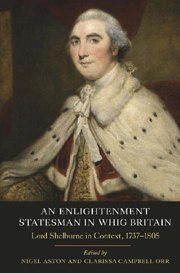Book contents
- Frontmatter
- Contents
- List of Illustrations
- List of Contributors
- Acknowledgements
- List of Abbreviations
- Introduction
- Part One Family, Piety, and Finance
- 1 Petty and Fitzmaurice: Lord Shelburne and his Brother
- 2 Aunts, Wives, Courtiers: The Ladies of Bowood
- 3 A Christian Whig: Lord Shelburne and the Latitudinarian Tradition
- 4 Lord Shelburne, Finance, and Sir Francis Baring
- Part Two Politics
- Part Three The Bowood Circle Revisited
- Index
- STUDIES IN EARLY MODERN CULTURAL, POLITICAL AND SOCIAL HISTORY
2 - Aunts, Wives, Courtiers: The Ladies of Bowood
from Part One - Family, Piety, and Finance
Published online by Cambridge University Press: 05 September 2013
- Frontmatter
- Contents
- List of Illustrations
- List of Contributors
- Acknowledgements
- List of Abbreviations
- Introduction
- Part One Family, Piety, and Finance
- 1 Petty and Fitzmaurice: Lord Shelburne and his Brother
- 2 Aunts, Wives, Courtiers: The Ladies of Bowood
- 3 A Christian Whig: Lord Shelburne and the Latitudinarian Tradition
- 4 Lord Shelburne, Finance, and Sir Francis Baring
- Part Two Politics
- Part Three The Bowood Circle Revisited
- Index
- STUDIES IN EARLY MODERN CULTURAL, POLITICAL AND SOCIAL HISTORY
Summary
This chapter will look not only at Shelburne's female relations by birth and marriage but also relate these aristocratic networks to the royal court. This brings out a third element: the continuing Irish dimension in Shelburne's personal life, despite his drive to repudiate a backwoods Irish destiny.
As I have argued elsewhere, there are various reasons why we need to work harder at integrating our knowledge of the aristocracy and their political leadership with the role of the court. Looking at courtier families leads naturally into looking at both women and men equally, as service in royal households was one of the few ways in which women could have a public, salaried career. The court was at the centre of British society and an important venue for political and social networking; successful ministers normally needed a good relationship with the monarch as well with aristocratic connections and the public. There can be no excuse, after Elaine Chalus's work on aristocratic elites, to overlook the social dimension of politics and women's role within it. This alone makes it essential to look as the Bowood ladies if we are to re-appraise Shelburne's career.
Both his wives, Sophia Carteret (1745–1761), daughter of John Carteret, Earl Granville, and Louisa Fitzpatrick (1755–1789), daughter of John Fitzpatrick, 1st Earl of Upper Ossory, brought useful social connections to the court and to very different Whig political families. They were themselves distantly related, through the marriage of Sophia's great-aunt Jane Granville to Louisa's great-great-grandfather, Sir William Leveson-Gower (Tables * and *).
- Type
- Chapter
- Information
- An Enlightenment Statesman in Whig BritainLord Shelburne in Context, 1737–1805, pp. 51 - 78Publisher: Boydell & BrewerPrint publication year: 2011

